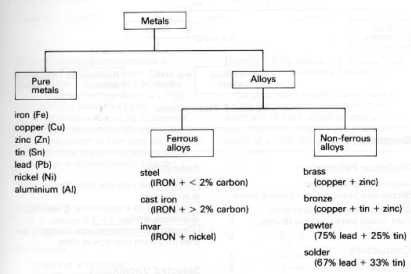Match a line in A with a line in B
А В
| 1. Copper was discovered | a. Yes, it is. |
| long ago. | b. Where exactly? |
| 2. Is copper used in automobile | с. You are welcome. |
| industry? | d. You are quite right. |
| 3. Bronze was first produced | e. Because of its valuable |
| in Asia and Africa. | properties. |
| 4. Why is copper so widely | f. Certainly. |
| used today? | |
| 5. Electric wiring is made of | |
| pure copper, isn't it? | |
| 6. Thank you very much. |
Use the table to complete the sentences.

FOR EXAMPLE:1. Brass is an alloy whereas aluminium is a pure metal.
2. Brass and pewter are non-ferrous alloys whereas steel is a ferrous alloy.
1. Brass is an alloy _______ aluminium ….
2. Brass and pewter … whereas steel is ….
3. Brass and bronze _____ copper alloys … and … lead alloys.
4. Zinc ____ an element _____ pewter ….
5. Solder … whereas invar ….
6. Steel has less than 2% of carbon _____ cast iron ….
Vocabulary Work
Learn how to read these words.
ductile ['daktail] recycling [ri'saikliη]
reliable [ri'laiəbl] plumbing ['plamiη]
decorative ['dekərətiv]
Match the Ukrainian words with their English equivalents.
| 1. оцінювати | a. qualities |
| 2. видобувати | b. conductor |
| 3. провідник | с purpose |
| 4. домашній | d. to extract |
| 5. в‘язкий (еластичний) е. ductile | |
| 6. нержавіючий f. domestic | |
| 7. якості | g. to estimate |
| 8. мета | h. corrosion resistant |
Translate the sentences into English using your active vocabulary.
1. В якості електричного провідника ми можемо використовувати мідь.
2. Він може пояснити як видобувають мідь у промислових цілях.
3. Ми змогли вивчити властивості алюмінієвої бронзи на практичних заняттях.
4. Бронза може чинити опір корозії.
5. Переваги міді в тому, що її можна переробляти декілька разів.
6. Мідні сплави можуть бути використані в різних галузях промисловості.
Reading and Speaking
8. These words are taken from the text. Use the dictionary to find out theirmeaning.
rather, adv
circulation, n
vital, adj
junked,adj
remainder, n
throughout, prep
discarded, adj
demand, n
9. Read the text attentively for more information about copper.
 Copper is man's oldest metal as people could extract it more than 10,000 years ago. As it is rather soft and ductile, copper is alloyed with other elements. There is evidence that the first copper alloy — bronze (90% copper, 10% tin) - was produced around 2800 ВС in countries such as India, Egypt and Mesopotamia. Bronze was harder and could be used for making reliable cutting tools. Its use characterizes the Bronze Age.
Copper is man's oldest metal as people could extract it more than 10,000 years ago. As it is rather soft and ductile, copper is alloyed with other elements. There is evidence that the first copper alloy — bronze (90% copper, 10% tin) - was produced around 2800 ВС in countries such as India, Egypt and Mesopotamia. Bronze was harder and could be used for making reliable cutting tools. Its use characterizes the Bronze Age.
 The workability and the ability for corrosion resistance made copper, bronze and brass the most important functional as well as decorative materials from the Middle Ages and on till the present day. With the beginning of the Electrical Age the demand for copper increased tremendously because it is an unusually good conductor of electricity and heat. Today more than 5 million tons of copper are produced annually and the copper metals are playing an increasingly vital part in all branches of modern technology.
The workability and the ability for corrosion resistance made copper, bronze and brass the most important functional as well as decorative materials from the Middle Ages and on till the present day. With the beginning of the Electrical Age the demand for copper increased tremendously because it is an unusually good conductor of electricity and heat. Today more than 5 million tons of copper are produced annually and the copper metals are playing an increasingly vital part in all branches of modern technology.
 The good news is that we will not run out of copper. The worldwide resources of this important and valuable metal can be estimated at nearly 5.8 trillion pounds of which only about 0.7 trillion (12%) have been mined throughout history. Besides, nearly all of 700 billion pounds is still in circulation because copper's recycling rate is higher than that of any other engineering metal. Each year nearly as much copper is recovered from recycled material as is obtained from newly mined ore. Almost half of all recycled copper scrap is old post-consumer scrap, such as discarded electric cable, junked automobile radiators and air conditioners, or even ancient Egyptian plumbing! The remainder is new scrap, such as chips and turnings from screw machine production. Engineers hope that we will be able to use copper for centuries on.
The good news is that we will not run out of copper. The worldwide resources of this important and valuable metal can be estimated at nearly 5.8 trillion pounds of which only about 0.7 trillion (12%) have been mined throughout history. Besides, nearly all of 700 billion pounds is still in circulation because copper's recycling rate is higher than that of any other engineering metal. Each year nearly as much copper is recovered from recycled material as is obtained from newly mined ore. Almost half of all recycled copper scrap is old post-consumer scrap, such as discarded electric cable, junked automobile radiators and air conditioners, or even ancient Egyptian plumbing! The remainder is new scrap, such as chips and turnings from screw machine production. Engineers hope that we will be able to use copper for centuries on.
